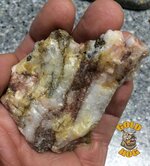Ragnor
Sr. Member
- Dec 7, 2015
- 445
- 422
- Primary Interest:
- All Treasure Hunting
So I have been thinking allot about my course of action when the ground starts to dry out. You'd have to be crazier than me to have been out in the woods the last few days in Western Washington. Plain unsafe.
Anyway to the point
When concidering an old river channel where would you dig first?
Without knowing the actual layout of the bedrock it seams a hard call to make.
I have an area, perhaps 100'x200' to concider. Elevation maps are scetchy at best as are my memories of the last time I was on site.
Lets say we have a leading edge in an arc 20' above , but following the current stream course. Alluvium yielding black sands are visible under a layer of pumice along the leading edge. The pumice layer is 3-4 feet deep. Now I know from past experience there is a low spot back away from the creek it is about centered in the described area. The pumice layer there is a minimum of 6' deep.
Now what I am thinking I want to do is determine the sub soil topography to make an educated guess where a transitional zone is in the underlayment as this is a likely place for placer deposition. Like a deep hole, drop off, sharp bend, etc.
I recall a story of native tribesmen who where helping a diamond prospector in equador. Rather than digging random holes all over the jungle they simply took long rods and probed through the forest floor feeling and listening for the rod to contact river gravel and in this way where able to prospect for buried river chanels. In this manner they did a weeks worth of work in only a day. I was concidering this method of sub surface mapping.
Now there are also likely to be some large cross cutting fractures in the bedrock under the till. Surface cracks in the scoured area would indicate this to be so.
I'm not sure if I should go for the cracks or go for the deepest spot or just start at the edge and follow the bedrock in a likely location. slabbing bedrock in a deep hole sounds like allot of work without a real big hole. In general this material slabs in 2'-3' square by 4'-6' long pieces. It don't break small.
So I figured I'd ask around on here and see what experience and opinions say. All work will be done by hand and money is tight so I need to get in and make a withdrawl as quickly and painlessly as possible. It's all virgin ground, it's just a matter of finding a good crack or boil hole on this small bench.
Anyone who has experience have advice on how to best proceed?
Anyway to the point
When concidering an old river channel where would you dig first?
Without knowing the actual layout of the bedrock it seams a hard call to make.
I have an area, perhaps 100'x200' to concider. Elevation maps are scetchy at best as are my memories of the last time I was on site.
Lets say we have a leading edge in an arc 20' above , but following the current stream course. Alluvium yielding black sands are visible under a layer of pumice along the leading edge. The pumice layer is 3-4 feet deep. Now I know from past experience there is a low spot back away from the creek it is about centered in the described area. The pumice layer there is a minimum of 6' deep.
Now what I am thinking I want to do is determine the sub soil topography to make an educated guess where a transitional zone is in the underlayment as this is a likely place for placer deposition. Like a deep hole, drop off, sharp bend, etc.
I recall a story of native tribesmen who where helping a diamond prospector in equador. Rather than digging random holes all over the jungle they simply took long rods and probed through the forest floor feeling and listening for the rod to contact river gravel and in this way where able to prospect for buried river chanels. In this manner they did a weeks worth of work in only a day. I was concidering this method of sub surface mapping.
Now there are also likely to be some large cross cutting fractures in the bedrock under the till. Surface cracks in the scoured area would indicate this to be so.
I'm not sure if I should go for the cracks or go for the deepest spot or just start at the edge and follow the bedrock in a likely location. slabbing bedrock in a deep hole sounds like allot of work without a real big hole. In general this material slabs in 2'-3' square by 4'-6' long pieces. It don't break small.
So I figured I'd ask around on here and see what experience and opinions say. All work will be done by hand and money is tight so I need to get in and make a withdrawl as quickly and painlessly as possible. It's all virgin ground, it's just a matter of finding a good crack or boil hole on this small bench.
Anyone who has experience have advice on how to best proceed?
Upvote
0









